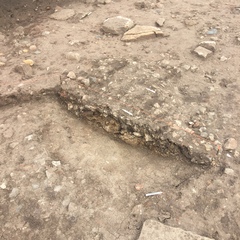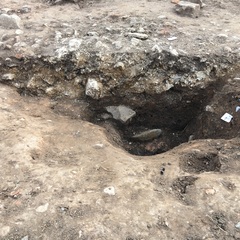Basic Information
- Partial in-situ remains of a heavily truncated metalworking pit
Contexts
-
Context: LDF_2034
-
Context: LDF_2040
-
Context: LDF_2135
-
Context: LDF_2424
- Fill of a possible metalworking waste pit F206 - same as (2135)
- Ben Swain
- 29-9-2022
-
Context: LDF_2504
- Burnt sandy fill of flue/Stoke hole related to possible metalworking hearth
- Chris Swindells
- 13-9-2023
-
Context: LDF_2507
- Burnt clay capping to potential flue in metalworking pit
- Ben Swain
- 14-9-2023
-
Context: LDF_2580
- Slither of in-situ metalworking hearth/pit fill on the northern edge of the pit, truncated by grave F734.
- Ben Swain
- 30-9-2023
-
Context: LDF_2581
- Central bulk of in-situ metalworking hearth/pit fill, truncated by graves F734 and F737
- Ben Swain
- 30-9-2023
-
Context: LDF_2582
- Cut of a possible flue/stokehole filled with sand and copper droplets inserted into metalworking pit F206
- Ben Swain
- 30-9-2023
Narrative
-
- A small pit in the north west extension of trench 2, it was 1.58m long and 1.52m wide, the exact depth is unknown but it is at 0.22m deep. This pit has had various different interpretations. It was first seen during the 2017 season of the project where it was interpreted as a plaster layer (2034) within a building, this has since been debunked as it would seem the upper material is not plaster but something related to lime slaking. The lower fill of the feature (2135) was excavated in the 2019 season and it is not certain whether this is associated with the feature or a layer the feature is cut into or possibly part of a larger pit fill. The current theory is that it was an anvil pit associated with the metalworking/blacksmithing activity seen in the area. It may be that it is undercut and part of a larger feature, but this seems unlikely now. It appeared to be capped by some sort of lime slaking debris or limestone deposit and then the basal fill was a soft brown clayey silt with evidence of burning (burnt wood/charcoal) within it. There has been various other finds associated with pit indicating metalworking, such as small droplets of copper/copper alloy waste and part of a possible flue pipe.
-
- Nat Jackson
- 1-10-2020
-
- The interpretation of this feature has varied considerably over the years since its discovery, however as of the end of the 2023 season it has become clear that it represents the heavily truncated in-situ remains of a metalworking hearth/pit - likely for the production of copper alloys and/or associated artefacts. Previous to 2023, it had been hypothesised that the feature was a pit solely used for the discarding of metalworking waste because the material found within (copper slag/droplets, charcoal chunks, burnt clay, hearth lining) all seemed mixed/churned and not in its original context. In 2023, it was discovered this was because the area had been heavily truncated by a number of graves (F731, F734 and F737). Upon the complete excavation and removal of these graves, it was observed below that there remained some sections of intact and in-situ metalworking hearth. Two sections of the original hearth/pit survive. One, as a slither against the northern edge of the pit as outlined by an intense blackened and reddened in-situ burnt clay semi circle filled with a mottled orange clay with charcoal chunks. The second, as a central bulk to the pit, truncated on either side by two graves. The cross-section through this bulk revealed various layers/lenses of charcoal and burnt clay repeating towards the base. These could indicate recurring firings of the hearth over time. Additionally, a square shaped shaft was observed in this cross section filled mostly with sand (partly vitrified) and charcoal/copper droplets with a layer of burnt wood at the base (100% sampled for C14 dating). This shaft could potentially represent some form of flue/stokehole or even a bellows chamber. The discovery of a partially surviving in-situ early medieval monastic copper-alloy metalworking hearth/pit is very significant - especially given the context and location on early Medieval Lindisfarne. The heavy truncation by later graves of this feature is a likely explanation for why it was previously interpreted as a metalworking waste pit - as indeed, most of the material recovered from the grave fills is out of its original context. However, the discovery of these graves and their subsequent removal has proven the existence of this in-situ metalworking hearth - even if only small elements of it survive undamaged. The newly discovered intact elements of the metalworking pit were left in-situ as of the end of the 2023 season to allow an appropriate sampling strategy to be created and implemented as part of the 2024 season.
-
- Ben Swain
- 30-9-2023
Dating Narrative
- No Interpretations


